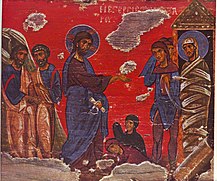Lazarus of Bethany | |
|---|---|
 Christ's raising of Lazarus, Athens, 12–13th century | |
| Four-days dead, friend of Christ | |
| Died | 1st century AD |
| Venerated in | Catholic Church Eastern Orthodox Church Oriental Orthodox Church Anglican Communion Lutheran Church Islam |
| Feast |
|
| Attributes | Sometimes vested as an apostle, sometimes as a bishop. In the scene of his resurrection, he is portrayed tightly bound in mummified clothes, which resemble swaddling bands. |
Lazarus of Bethany (Latinised from Lazar, ultimately from Hebrew Eleazar, "God helped") is a figure within the Christian Bible, mentioned in the New Testament in the Gospel of John, whose life is restored by Jesus four days after his death. This is seen by Christians as one of the miracles of Jesus. In the Eastern Orthodox Church, Lazarus is venerated as Righteous Lazarus, the Four-Days Dead.[4] The Eastern Orthodox and Catholic traditions offer varying accounts of the later events of his life.
In the context of the seven signs in the Gospel of John, the raising of Lazarus at Bethany – today the town of Al-Eizariya in the West Bank, which translates to "the place of Lazarus" – is the climactic narrative: exemplifying the power of Jesus "over the last and most irresistible enemy of humanity: death. For this reason, it is given a prominent place in the gospel."[5]
The name Lazarus is frequently used in science and popular culture in reference to apparent restoration to life; for example, the scientific term Lazarus taxon denotes organisms that reappear in the fossil record after a period of apparent extinction, and also the Lazarus sign and the Lazarus syndrome. There are also numerous literary uses of the term.
A distinct character of the same name is also mentioned in the Gospel of Luke in Jesus' parable of the rich man and Lazarus, in which both eponymous characters die, and the former begs for the latter to comfort him from his torments in hell.
- ^ Great Synaxaristes: (in Greek) Ἀνάστασις τοῦ Λαζάρου. ΜΕΓΑΣ ΣΥΝΑΞΑΡΙΣΤΗΣ.
- ^ Great Synaxaristes: (in Greek) Ὁ Ἅγιος Λάζαρος ὁ Δίκαιος, ὁ φίλος τοῦ Χριστοῦ. 17 ΜΑΡΤΙΟΥ. ΜΕΓΑΣ ΣΥΝΑΞΑΡΙΣΤΗΣ.
- ^ Great Synaxaristes: (in Greek) Ἀνακομιδὴ καὶ Κατάθεσις τοῦ Λειψάνου τοῦ Ἁγίου καὶ Δικαίου Λαζάρου. 17 Οκτωβρίου. ΜΕΓΑΣ ΣΥΝΑΞΑΡΙΣΤΗΣ.
- ^ Holland, Fr. Seraphim. "The Resurrection of Lazarus, the Four Days Dead, of Bethany". Pravoslavie.ru. Archived from the original on 7 January 2019. Retrieved 7 January 2019.
- ^ Tenney, Merrill C. Kenneth L. Barker & John Kohlenberger III (ed.). Zondervan NIV Bible Commentary. Grand Rapids, Michigan: Zondervan Publishing House.